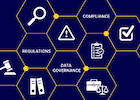Data auditing is the assessment of data for quality throughout its lifecycle to ensure its accuracy and efficacy for specific usage. Data performance is measured and issues are identified for remediation. Data auditing results in better data quality, which enables enhanced analytics to improve operations.
Data Auditing

Issues Uncovered by Data Auditing
- Identifies systemic data issues
- Incomplete data sets
- Data security gaps
- Barriers to data access
- Siloed data
- Insufficient depth or breadth of data collection
Data Auditing Benefits
- Identifies systemic data
- Improves data quality
- Enables more effective data analytics
- Provides risk assessment
- Supports compliance adherence
Why Data Auditing is Needed
Data auditing underpins all data-related activities. Organizations learn where their data is as well as gain insights into its quality, security, usage, and efficacy as a resource for operations and analytics.
Three Key Data Auditing Functions
1. Data Quality
Identifies inaccurate data and root causes—allowing organizations to implement processes to remediate issues.
2. Regulatory Compliance
Helps organizations adhere to corporate, industry, and government regulations by providing deep visibility into the location, usage, and data security.
3. Improve Operations
From sales and marketing to customer service and human resources, data auditing up-levels data quality, making operations run more smoothly and effectively.
Questions that Data Auditing Answers
Data auditing answers questions related to data that uncover issues, reinforce compliance, and support strategic uses of data.
- What data is being collected?
- Should other data be collected?
- Is unnecessary data being collected?
- Where is data stored?
- Does data storage meet operational and regulatory requirements?
- Are the appropriate data protection systems in place?
- Has a lifecycle been defined for data, including an “end of life” date?
- Have functions been assigned to all data elements?
- Has data been appropriately classified?
- What is the process for honoring a request to delete data?
8 Ways Data Auditing Helps Organizations
- 1. Supports the safeguarding of data assets
- 2. Ensures that data access controls are working
- 3. Flags and identifies the source of unauthorized data access
- 4. Identifies policy flaws that could introduce vulnerabilities
- 5. Helps improve internal data-related processes
- 6. Includes forensic analysis to detect fraud, intrusion, and insider threats
- 7. Supports rapid response to data-related issues
- 8. Reviews third-parties' (e.g., partners’, vendors’) activities
How Data Auditing is Performed
Five Key Components
1. Stakeholders
Data is stored and used across organizations as well as in off-prem storage and cloud applications. Data auditing must engage the creators, collectors, users, and managers of all data.
By engaging with stakeholders who represent an organizations’ information, data auditing delivers valuable insights into data collection, storage, and usage processes. Also, understanding the unique challenges of stakeholders helps focus on areas that are of specific interest to those groups.
2. Information
Successful data auditing depends on reviewing all information, which means that its location must be identified, and it must be clear what the data element is. The first data audit can be tedious, because data maps must be created.
When creating data maps, it is important to include data that is located in offsite storage, with partners, and in cloud applications. Also, unstructured data should be included in data auditing programs. Once data maps have identified the location of all data elements, auditing is easier, and more sophisticated work can be done.
3. Objectives
Before beginning data auditing, establish goals and success metrics. These should be based on the organizations’ needs and take into account stakeholders’ objectives.
Specific objectives that need to be considered are data quality (i.e., with regard to accuracy), depth, breadth, and consistency, among other criteria. The ultimate objective of data auditing is to ensure the optimal performance of data. A clear understanding of where data resides is required, followed by identifying any issues that need remediation.
4. Implementation
Data cleansing is an important step in data auditing; determining what is not necessary (e.g., obsolete, duplicate), and then archiving or destroying it. Data auditing should also include an assessment of data quality.
Once data has been cleaned up, systems and processes need to be established for ongoing data auditing. These include deploying technology to automate many auditing functions, such as checking for data accuracy, consistency, timeliness, validity, classifications, security, and compliance.
Automation leaves data auditors free to focus on more meaningful work that cannot be done effectively with automated tools, including reviewing anomalies, recommending remediation, and interpreting analytical results.
5. Maintenance and Monitoring
The final component supports keeping track of data throughout its lifecycle. Data auditing is a continual process that uses data policies and procedures to ensure that data is properly managed.
With data auditing, data creation, collection, usage, storage, and destruction are monitored to ensure adherence to rules and identify anomalies or issues related to data quality and data security. This also includes maintaining systems and evaluating processes with an eye toward prioritization and optimization.
Evaluating Data Quality
Assessing the quality of data is a critical function of data auditing. Technology plays a key role in this, automating the process of evaluating data quality.
Data auditing takes accuracy into account, detecting errors produced by humans, bots, algorithms, and system glitches.
It also evaluates consistency to ensure that specified formats and protocols are followed for each data element.
Automated Data Auditing
A key role of technology in data auditing is automation. Many repetitive tasks lend themselves to automation.
Automating data auditing functions expedites the evaluation of data health criteria, such as accuracy, consistency, and usage. With software, workflows can be created.
Automation has a number of benefits, including:
- Automate data element classification
- Eliminate error-prone manual processes
- Increase use of metadata connectors
- Improve stakeholder satisfaction
- Enhance data quality
Don’t Be Daunted by Data Auditing
Data auditing prevents the cascade effect of poor data quality and security which can negatively affect all areas of an organization. It provides visibility into all of an organization’s information.
With data auditing, data is routinely assessed to detect errors and anomalies. Done well, it also identifies data silos that should be rearchitected to provide cross-organizational access.
An organization’s first foray into data auditing can be daunting. However, it is not hard once a process has been created, and the results far outweigh the effort. The results of regular data auditing are improved analytics and business operations along with significantly reduced costs for data maintenance.
Get started with Egnyte.
Last updated: 06/02/2021
Additional Resources


Secure Business Collaboration
See how full audit capability ensures the right people have content access.

Data governance for regulatory compliance: lessons learned from NYDFS
Learn how an automated permissions auditing tool supports compliance.

Get started with Egnyte.
Contents
- Why Data Auditing is Needed
- How Data Auditing is Performed
- Evaluating Data Quality
- Automated Data Auditing
- Don’t Be Daunted by Data Auditing